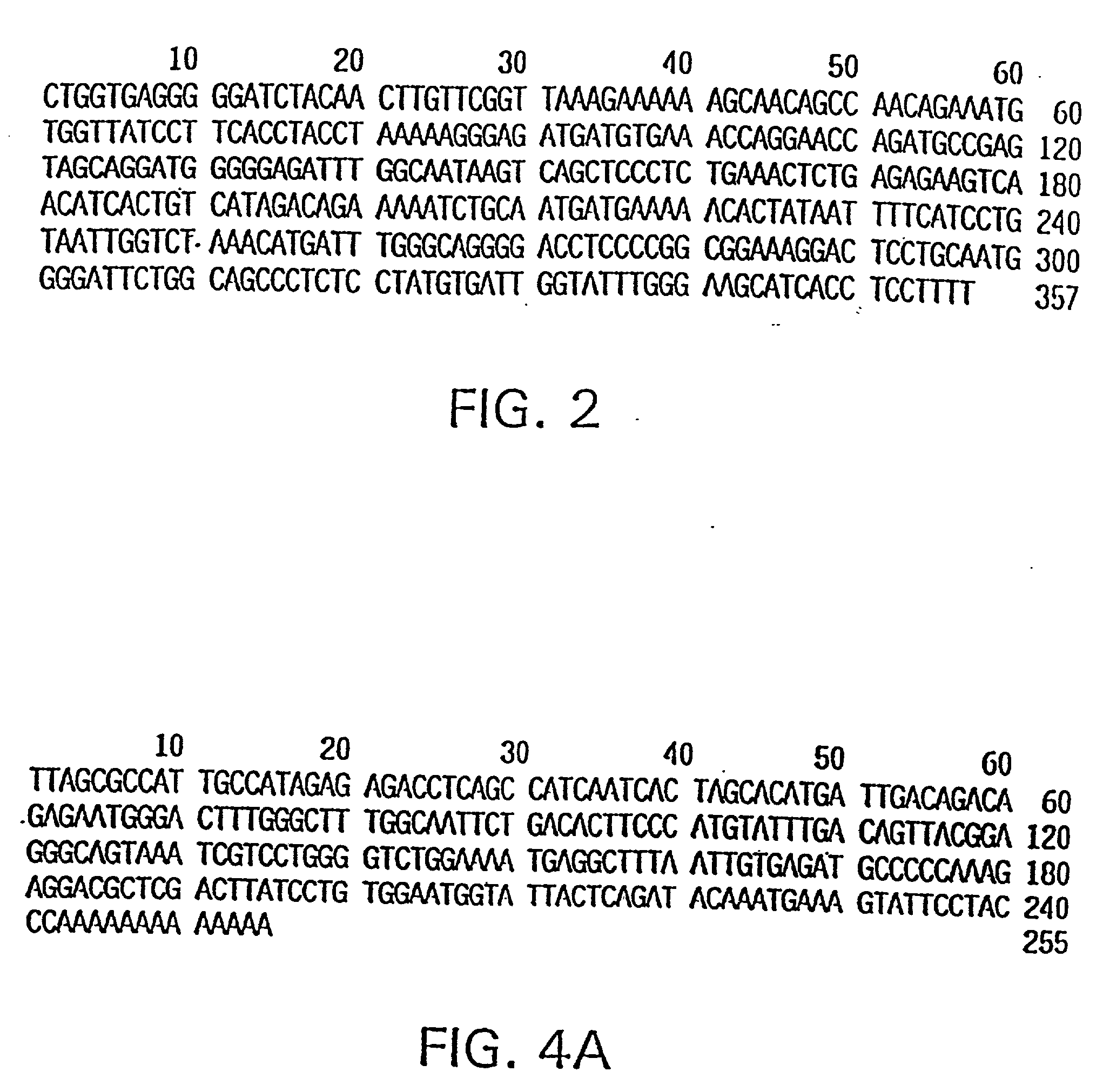[0037] The invention is based, in part on
systematic search strategies involving paradigms which utilize TH0, TH1, TH2, TH1-like and TH2-like cells, in systems which mimic the activity of the
immune system or immune disorders, coupled with sensitive and high-
throughput gene expression assays, to identify genes differentially expressed within and / or among TH
cell subpopulations. In contrast to approaches that merely evaluate the expression of a single known
gene product presumed to play a role in some immune cell-related process or disorder, the search strategies and assays used herein permit the identification of all genes, whether known or novel, which are differentially expressed within and among TH
cell subpopulations, as well as making possible the characterization of their temporal regulation and function in the TH
cell response and / or in TH cell mediated disorders. This comprehensive approach and evaluation permits the discovery of novel genes and gene products, as well as the identification of a
constellation of genes and gene products (whether novel or known) involved in novel pathways (e.g., modulation pathways) that play a major role in the TH-cell mediated immune responses and TH cell subpopulation-related disorders. Thus, the present invention makes possible the identification and characterization of targets useful for prognosis, diagnosis, monitoring, rational
drug design, and / or therapeutic intervention of
immune system disorders.
[0045] The 10
gene product is a 338
amino acid receptor molecule which is a particularly suitable target for such a program in that the 10
gene product belongs to a class of proteins having a seven
transmembrane domain sequence motif, which tend to represent
G protein-coupled
receptor molecules. The 10 gene product structure, therefore, indicates that it may be involved in
signal transduction events which may be important to
T cell responses in general, and further indicates that modulation of 10 gene product may effectively ameliorate a wide range of
T cell-related disorders.
[0046] Specifically, because the 10 gene product is a transmembrane product, its activity, via either a
physical change in the number of 10 gene-expressing cells or by a change in the functional level of 10 gene product activity, can be particularly amenable to modulation. For example, natural ligands, derivatives of natural ligands and antibodies which bind to the 10 gene product can be utilized to reduce the number of induced T cells present by either physically separating such cells away from other cells in a
population, or, alternatively, by targeting the specific destruction of the induced T cells or inhibiting the proliferation of such T cells.
[0047] Additionally, compounds such as 10 gene sequences or gene products such as, for example, soluble 10 gene products, can be utilized to reduce the level of induced
T cell activity, and, ultimately, bring about the amelioration of a wide range of T cell-related disorders. For example, in the case of soluble gene 10 gene products, the compounds can compete with the endogenous (i.e., natural) ligand for the 10 gene product, leading to a modulation of induced T
cell activity. Soluble proteins or peptides, such as peptides comprising one or more of the
extracellular domains, or portions and / or analogs thereof, of the 10 gene product, including, for example, soluble fusion proteins such as Ig-tailed fusion proteins, can be particularly useful for this purpose. Additionally, antibodies directed against one or ore of the
extracellular portions of the 10 gene product may either reduce 10 gene
product function by, for example, locking ligand binding. Additionally, antibodies directed against the 10 gene product can, in certain instances, serve to increase the level of 10 gene product activity.
[0050] The identification of TH cell subpopulation specific markers can be utilized in the treatment of a number of immune disorders, especially TH cell subpopulation-related disorders. For example, markers for the TH2 subpopulation can be used to ameliorate conditions involving an inappropriate IgE immune response, including but not limited to the symptoms which accompany atopic conditions such as
allergy and / or
asthma. IgE-type antibodies are produced by stimulated B cells which require, at least in part, IL-4 produced by the TH2 cell subpopulation. Therefore, a treatment which reduces the effective concentration of secreted IL-4, e.g., by reducing the activity or number of TH2 cells, will bring about a reduction in the level of circulating IgE, leading, in turn, to the amelioration or
elimination of atopic conditions. Any of the TH2-specific gene products described herein can, therefore, be used as a target to reduce or deplete the number and / or activity of TH2 cell subpopulation cells for the treatment of such conditions.
[0055] Further, the Example presented in Section 12, below, describes successful use of antibodies directed against the 103 gene product as well as 103 / Ig fusion proteins to ameliorate symptoms of
asthma in an accepted
animal model for the TH2-
related disorder. Thus, the results indicate that the 103 gene product provides a
critical signal to TH2 cells and can successfully be used as a target for
selective modulation of TH immune responses (e.g., for selective suppression of TH2 immune responses and / or selective enhancement of TH1 immune responses).
 Login to View More
Login to View More 


